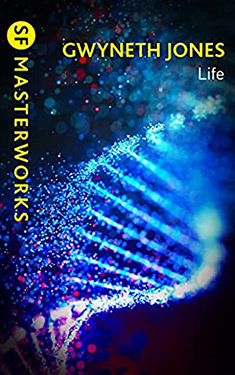Gwyneth
Jones
Completed 6/2/2020,
Reviewed 6/2/2020
2 stars
This was a
real slog of a book. It was a very long slice
of life book about a tortured but brilliant scientist and her college friends over
a period of about twenty years or so. It
wasn’t classic science fiction; it was general fiction with a little science
thrown in. Her devotion to science was
the reason why her life and relationships were so bad. However, like a good Brit, she had a stiff
upper lip, living in a lot of denial and repression, not dealing with the
issues in her life until it all comes to a head at the end. I didn’t like it, but it did win a Philip K.
Dick Award and was nominated for the Otherwise Award.
 The story
begins in college, where Anna, a microbiology student, meets a group of people
who become lifelong friends. Near the
end of one of the years, she has a sexual affair with one of them, an American
foreign exchange student named Spence. Anna
goes on to graduate school and while working on her doctorate, finds an anomaly
with the interaction of the X and Y chromosomes that could mean a new step in
the evolution of human sexuality. Anna
meets up with Spence again and eventually they get married. No one wants to fund her research but she
becomes obsessed with it, working on it in between other projects. Her obsession with it ends up interfering
with everything in her life.
The story
begins in college, where Anna, a microbiology student, meets a group of people
who become lifelong friends. Near the
end of one of the years, she has a sexual affair with one of them, an American
foreign exchange student named Spence. Anna
goes on to graduate school and while working on her doctorate, finds an anomaly
with the interaction of the X and Y chromosomes that could mean a new step in
the evolution of human sexuality. Anna
meets up with Spence again and eventually they get married. No one wants to fund her research but she
becomes obsessed with it, working on it in between other projects. Her obsession with it ends up interfering
with everything in her life.
What I didn’t
like most about the book was that I never became interested in any of the
characters, not Anna, Spence, or a major secondary character Ramone. Anna was too emotionless. I never felt that she had a passion for her
research, just a cold obsession. And you
never get the impression that she was capable of love. Spence was also uninteresting, although at
least he was in love with Anna. Ramone
was a colorful character, a woman-hating woman with weird sexual fetishes. She’s obsessed with Anna but Spence gets to
Anna first. Despite her quirks, I was
never interested with where her character development went.
The prose is
lyrical, but boring and hard to read. I
didn’t like how the perspective often switched between third person narration and
first person thoughts. You’re reading
about Anna’s actions in third person, then suddenly you’re in her head as she
thinking about something in first person.
Then it reverts back to describing actions in third person. Rather than feeling like the book flowed,
this style was jarring and difficult to follow.
The author
has a note at the end of the book that this kind of science, sexual genetics,
has always intrigued her. There just
wasn’t enough of it though. It’s not
that I’m interested in X and Y chromosomal behavior, but it’s clear that you
could have thrown just about any scientific breakthrough in there and the
outcome would have been the same. It
doesn’t really affect anything until the very end, and even there it seems more
like an afterthought than a conclusion.
One thing I
did like about the book was that it brings to light the plight of the woman
scientist in a world dominated by men.
There’s a lot of sexual politics that frustrates Anna and she doesn’t
handle it well, nor does she know how to play the game with her male colleagues
and superiors. Yet her discovery is
something that should win a Nobel Prize since it revolutionizes the whole way
of thinking about sexual expression and genetics. The book unfortunately never gets that far
into the future. You wish it would just
to see some positive feedback on her lifetime of frustrated work. In the last half of the book, I was thinking,
please, just give her a little redemption of some sort.
I give the
book two stars out of five. It’s an
ambitious work, but lacking in many areas.
It doesn’t really feel like science fiction, or even meta. As I said before, it’s just general fiction
with a little science thrown in. It felt
like a boring, fictionalized biography of someone with only one interesting
quality: her research. Oh yeah, I never
figured out the significance of the cover.
It has two Asian women in traditional garb. There’s a passing reference to Asian woodcuts
(I can’t remember from which country) but it is so fleeting as not to be
memorable.
No comments:
Post a Comment